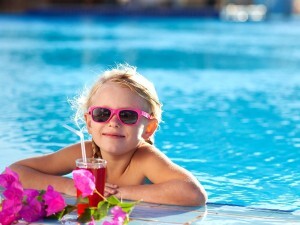Outdoor pools need treatment to maintain proper balance and sanitation levels. Chlorine has powerful sanitizing effects on water because it kills bacteria and algae that can lead to an unwanted murky or green appearance. Chlorine also acts as an oxidizer to control oils and debris. Tap water is even treated with chlorine, but there are many who do not like chlorine for its minor health risks. Large amounts of chlorine can cause upset stomach or skin and eye irritation. It can also have a bleaching effect on hair, causing undesired texture and color changes. If you are looking for a less harsh alternative to chlorine for your pool, consider these popular options.
Bromine
As a close relative to chlorine, bromine has many of the same sanitizing effects on water. It can kill harmful bacteria with less irritation to the skin. When it comes to oxidization, however, bromine is not quite as powerful, which can turn the water a slight green color. Chlorine-bromine combination options are available such as BCDMH tablets. They are made with mostly bromine and a small amount of chlorine to help with oxidization. Bromine salt can also be combined with oxygen shock to sanitize and oxidize pool water.
PHMB
Some pool maintenance chemical brands use a PHMB compound to eliminate the need for chlorine. PHMB sanitizes water by killing microorganisms by forming insoluble particles with water pollutants, which then get caught by the pool’s filter. Many pool owners prefer PHMB to chlorine because it has less damaging effects on hair and skin and is easier to keep the proper balance. Much like bromine, however, PHMB has poor oxidization qualities.
PHMB is incompatible with chlorine, but hydrogen peroxide, algaecide, and regular filter cleanings can be used to do what PHMB cannot. Due to PHMB’s incompatibility with chlorine, you must first completely drain and clean your pool before switching to PHMB. This includes any items you put in the pool, such as bathing suits, toys and cleaning devices.
Ozone Generators
Ultraviolet (UV) light and corona discharge systems can be used to sanitize water without the need for harsh chemicals. The installation of low-pressure UV lamps in the pools plumbing line kill water-borne pathogens using ozone. Corona discharge generators act similarly by creating ozone with an electrical arc. Some chlorine is still needed with ozone generators, but it is only about 10 to 20 percent of the amount regularly used. Ozone generators can be expensive and require some energy to run continuously, although the energy used is equivalent to a 60-watt light bulb.
Salt Chlorine Generator
Chlorine is relatively safe when diluted in water, but handling concentrated chlorine tablets can be risky. Salt chlorine generators can be installed in your pool to transform regular table salt into a less harsh form of bacteria-killing chlorine. The generator automatically checks the chlorine levels, eliminating the need for daily water testing. Skin, eye and hair irritation is uncommon in pools with salt chlorine generators, and pool guests may even comment that their skin feels softer.
The generators can be a bit pricey, but the maintenance can save you money over time as pool salt is less expensive than chlorine tablets. Saltwater can come with its own disadvantages as well, such as dulling the shine of metal pool equipment.
Chlorine is popular for use in pools because of its cost-effective sanitation and oxidization properties, but the irritation can be too much for some. Going completely chlorine-free can be a challenge, but using a method to limit chlorine use can have positive effects. Consider the chlorine-free options for pool sanitation and oxidization to improve the quality of your pool water while keeping it free of harmful contaminants.
